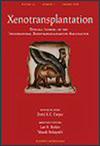First transplantation of a pig heart from a multiple gene-modified donor, porcine cytomegalovirus/roseolovirus, and antiviral drugs.
IF 4.1
4区 医学
Q2 MEDICINE, RESEARCH & EXPERIMENTAL
引用次数: 2
Abstract
The porcine cytomegalovirus (PCMV) is actually a porcine roseolovirus (PRV).1 As the official International Committee on Taxonomy of Viruses (ITCV) name, suid betaherpesvirus 2 (SuBHV2),2 is not widely used, the abbreviation (PCMV/PRV) will be used to make clear that it is a herpesvirus not closely related to the human cytomegalovirus (HCMV), but to the human herpesviruses 6 and 7 (HHV-6, HHV7), which are also roseoloviruses.3 PCMV/PRV was shown to reduce significantly the survival time of pig xenotransplants in non-human primates. Yamada et al.4 and Sekijima et al.5 reported a reduction of the survival time of pig kidneys from PCMV/PRV-positive donor pigs when transplanted in cynomolgus monkeys and baboons, respectively, in 2014. Already in 2002 Mueller et al.6 reported an activation PCMV in a pig-to-primate model of xenotransplantation in animals with short survival times. In 2016 for the first time an active replication of PCMV following transplantation of a pig heart into a baboon despite undetected virus in the donor pig was reported.7 Denner et al.8 reported a reduction of the survival time of genetically modified pig hearts in baboons. For detailed reviews of these and other studies see Denner.9,10 PCMV/PRVwas also transmitted to the human recipient who received a pig heart in January 2022 in Baltimore, Maryland, USA.11 The clinical features and the steadily increasing virus load observed in the patient in Baltimore are very similar to the features and high virus load observed in baboons, which received a PCMV/PRV-positive heart in Munich.8 Therefore, it is likely that the virus contributed together with other factors to the death of the首次移植来自多基因修饰供体的猪心脏,猪巨细胞病毒/玫瑰病毒,以及抗病毒药物。
本文章由计算机程序翻译,如有差异,请以英文原文为准。
求助全文
约1分钟内获得全文
求助全文
来源期刊

Xenotransplantation
医学-医学:研究与实验
CiteScore
6.80
自引率
15.40%
发文量
58
审稿时长
>12 weeks
期刊介绍:
Xenotransplantation provides its readership with rapid communication of new findings in the field of organ and tissue transplantation across species barriers.The journal is not only of interest to those whose primary area is xenotransplantation, but also to veterinarians, microbiologists and geneticists. It also investigates and reports on the controversial theological, ethical, legal and psychological implications of xenotransplantation.
 求助内容:
求助内容: 应助结果提醒方式:
应助结果提醒方式:


